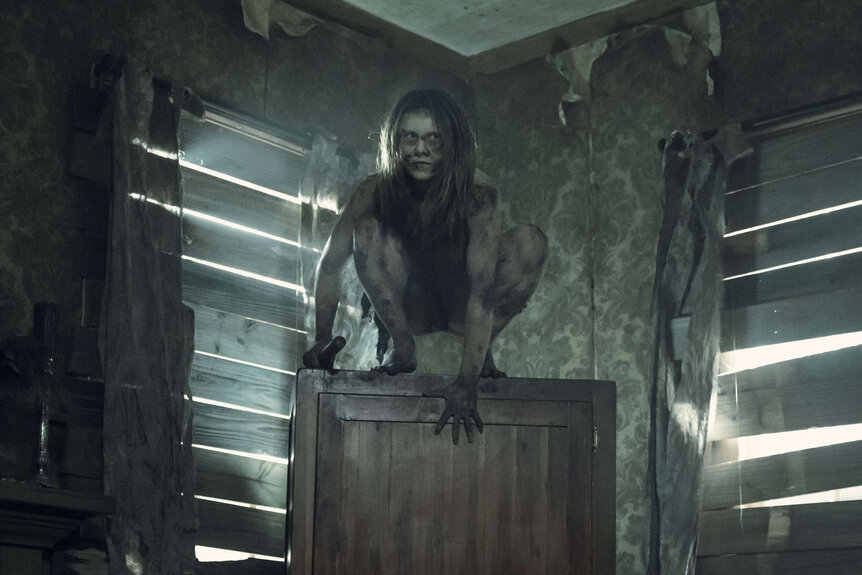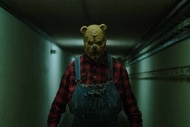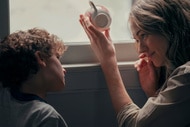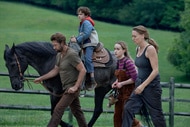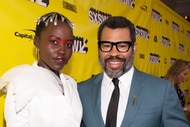Create a free profile to get unlimited access to exclusive videos, sweepstakes, and more!
Greg Nicotero breaks down The Walking Dead's most George Romero-esque episode ever
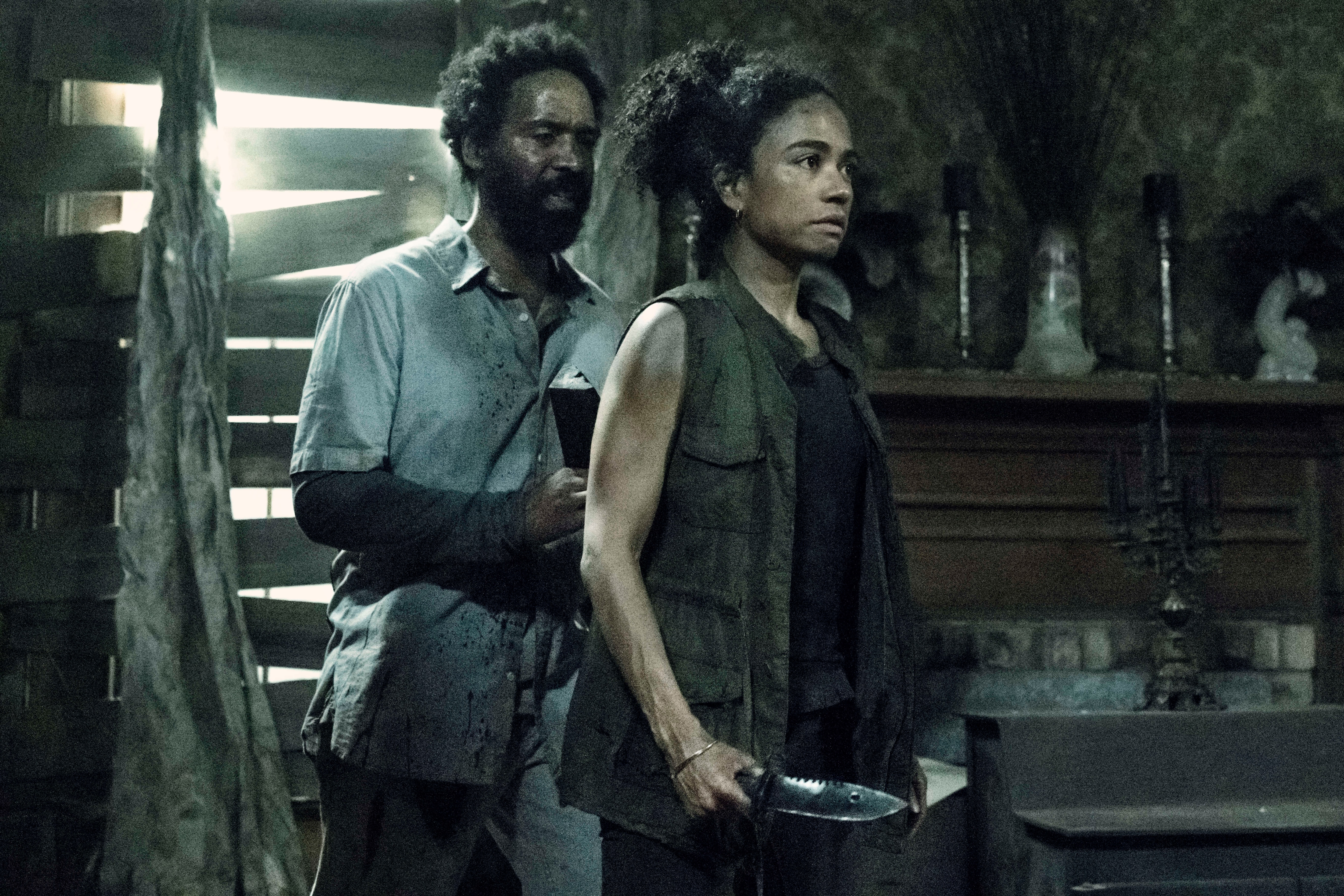
As the elder statesman of AMC's The Walking Dead series, Greg Nicotero first created and executed the series' special effects from the pilot forward, and then graduated to directing in Season 2. Eleven years later, he's directed 33 episodes of the series, with the latest airing last night. "On the Inside" presents a genuinely terrifying A-story featuring an exhausted Connie (Lauren Ridloff) and Virgil (Kevin Carroll) stuck inside a house of horrors with feral cannibals, while a pack of walkers wait for them outside.
Earmarked by showrunner Angela Kang as one for Nicotero, it's surprisingly only the second episode of Season 11 helmed by him. For the last six seasons, Nicotero has directed the season premieres but he wasn't able to this time around due to his showrunning/directing duties on AMC's Creepshow revival.
"I'll be honest, it was strange because usually I take the ship out of the dock," Nicotero tells SYFY WIRE via phone. "But we shot Season 2 and 3 of Creepshow back to back, so that kept me from being able to work on any of the interim episodes." But now he's back with a bang (bite?), as "On the Inside" genuinely achieves the scares not seen on the series in some time.
In this exclusive post mortem, Nicotero tells us the horror influences for the ferals, how he conveyed the terrifying impact of Connie's deafness in this episode and shooting the final season The Walking Dead.
"On the Inside" features one of the scariest stories portrayed in the series in some time. How was it bringing that aspect of the episode to life?
I really liked the departure. I like the idea that we were able to step into the horror roots of Wes Craven's and John Carpenter's world because I worked on a movie called The People Under the Stairs back in the day, so I was channeling some of the great horror directors that I had worked with in the past. Plus having two seasons of Creepshow under my belt definitely kept me sharp which I think was something really unique because with Creepshow you get three days per story.
So, I know how to shoot fast and I know how to shoot efficiently. I know how to work with actors and I know how to get material done that's good. It's not just shooting it, it's actually shooting it well. Coming into this after having been shooting for a year straight, I felt like I was a well-oiled machine, as much as I can be for me, at that particular point. And everybody that read the script was like, "Oh, man, we can't wait to see six!" Because even for people on the crew, it was such a departure for us.
Was the script very specific in how to execute the feral house or did you have a lot of input in realizing this house of horrors?
[Angela] really let me run with it. In terms of designing the feral makeups, obviously, I designed the makeups. I collaborated with Monty Simmons, our stunt coordinator. I told him how I wanted the movement because I thought that the movement was critical to differentiating these characters with walkers. They do need to be thin, they do need to have dirt and wounds and scrapes, and their hair has got to be long. I wanted to make sure that the audience knew that we were dealing with a different kind of animal. We auditioned a bunch of stunt performers. We had like a Cirque du Soleil performer in there.
Once we had the movement, I always looked at the ferals as a cat and mouse. They like playing with their food before they eat it. And there's the idea that they're in the room with you watching you. They're very methodical about the way that they hunt you down, and that was something that I really enjoyed. And building the set that we did in the hallways that had that maze feel to it, the opening is pure George Romero out of Night of the Living Dead. When those zombies are climbing against the windows, I was like, 'Guys, this is the closest that we've ever done to shooting something like Night of the Living Dead.' I felt like I had a great opportunity to channel some of these other classic horror moments from these directors.
Talk about working with Lauren Ridloff in this episode because she is selling the terror as Connie in every scene.
Lauren is absolutely one of the most magnificent actresses that I've ever worked with. She understands how to communicate sheer terror. And the most interesting thing that a lot of people forget about the horror genre is, if the characters in the scene aren't scared, then the audience won't be scared because the audience connects with the characters. So when you see Lauren with her eyes wide open, holding her breath and leaning up against the wall, and wildly looking from side to side, the audience is going to feel that.
The audience is gonna feel that because that's the connection. She's such a relatable actress that between her and Kevin, who also did a fantastic job, you feel like you're in there with them and that's critical to any any piece of material. If you don't feel with the actors, then then you're not going to connect.
The lack of audio during her scenes was so effective. Was that a choice that came in the edit?
We did play with that in the edit, because one of the most potent tools in horror is what you hear and not see. When I was cutting the episode together at the beginning, I went back and forth on [asking] is this something that we want the audience to hear? You know, it's like the old Hitchcock [technique] where there's a bomb under the table and the audience knows it, but the characters don't know it. That was one way that we had approached it. I think in the script, it was like, "All the sound drops out." And then when we were cutting it, I thought I'd like to hear it both ways just to see just to see how it plays. Ultimately, we ended up landing on letting the sound drop out. And I actually shot that pickup of her hand feeling the wall and feeling the vibration.
It really implied a realism to the heightened moments. Did that come from something specific?
I learned sign language during that episode. Not very well, but I wanted to be able to talk with Lauren and communicate with her. She told me while we were shooting that a hearing impaired person would never walk into a dark room and stand in the middle of the room. They would always use the wall because they wouldn't necessarily hear something coming up behind them. When we did the first rehearsal, we were signing and she had basically told me that her back would be to the wall because she would not want anything coming up behind her.
The ending also gave us great emotional catharsis by reuniting Kelly (Angel Theory), Connie and Magna (Nadia Hilker).
When we shot the reunion scene with both Angel and Lauren, we agreed that they wouldn't see each other until we shot because they hadn't seen each other in like a year and a half. We didn't do any rehearsals for that scene. We shot everything up to that moment and then I trained all cameras on them. Then Angel came around the corner and we shot it live. I love being able to give the actors those tools. And Nadia was interesting because she was there going, "I had a relationship with her too and I feel like I would be a part of this reunion." I said, 'Absolutely you would!' In the script, she was just kind of there after Kelly and Connie had their reunion. Then Nadia said, "I feel like I would be up there." We did another take and it was a nice little piece for her character.
It's the last season of The Walking Dead, but does it feel that way for you and the crew? There's still a ways to go with production, but are you savoring it more yet?
You know, it's hard to tell. The machine runs differently because of the state of the world and COVID. It does feel a little different, only because in the past where there would be a lot of people that would come by the set and hang out, that doesn't happen as much anymore. If the actors aren't working, they're not on set, so that's a little strange. And it's a little strange to be on set and not be able to see people's faces. The actors have face shields on but Melissa said to me, "I miss your face." We have to be careful and cautious and responsible. So, it's hard to say, but I added up the number of people that had been on the show since Season 1, and there's like 18 of us and that's it.
And those 18 people have a very different experience, because we started at the beginning. They were there for one of the greatest scenes that we ever shot which was Lennie James sitting in his window, trying to aim his gun at his zombie wife on the streets in front of the house. In my opinion, it was one of the greatest moments we ever shot. Or Daryl seeing Merle as a walker. There were so many great moments. I'm thinking more and more about those moments as we come to an end. I joked around with Scott Gimple, and said, 'The ad campaign should be: When did you fall in love with The Walking Dead?' Because there's so many moments. I don't know how it's gonna feel when we're done because I'm sort of in denial [of not seeing] these people that I've grown with, these people that I've watched their children grow up, and I've watched them get married, I've watched them send their kids off to school. It's an experience that I'll never have, again, because of the nature of what it is.
Would you be open to sticking around for the Daryl/Carol spin-off or anything else?
I feel like The Walking Dead has a lot of my DNA in it and I love that and I'm grateful for the opportunities that the show has given me. If I have an opportunity to continue and to collaborate on future projects, of course, I would want to do that because it's kind of like raising my kid, you know?
New episodes of The Walking Dead premiere Sundays on AMC at 9 p.m. Eastern.
